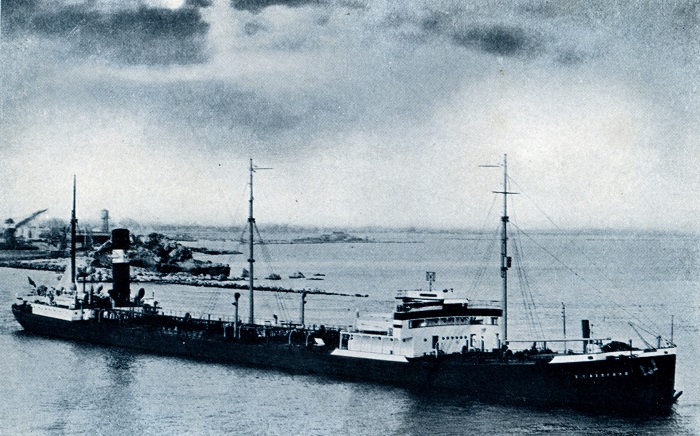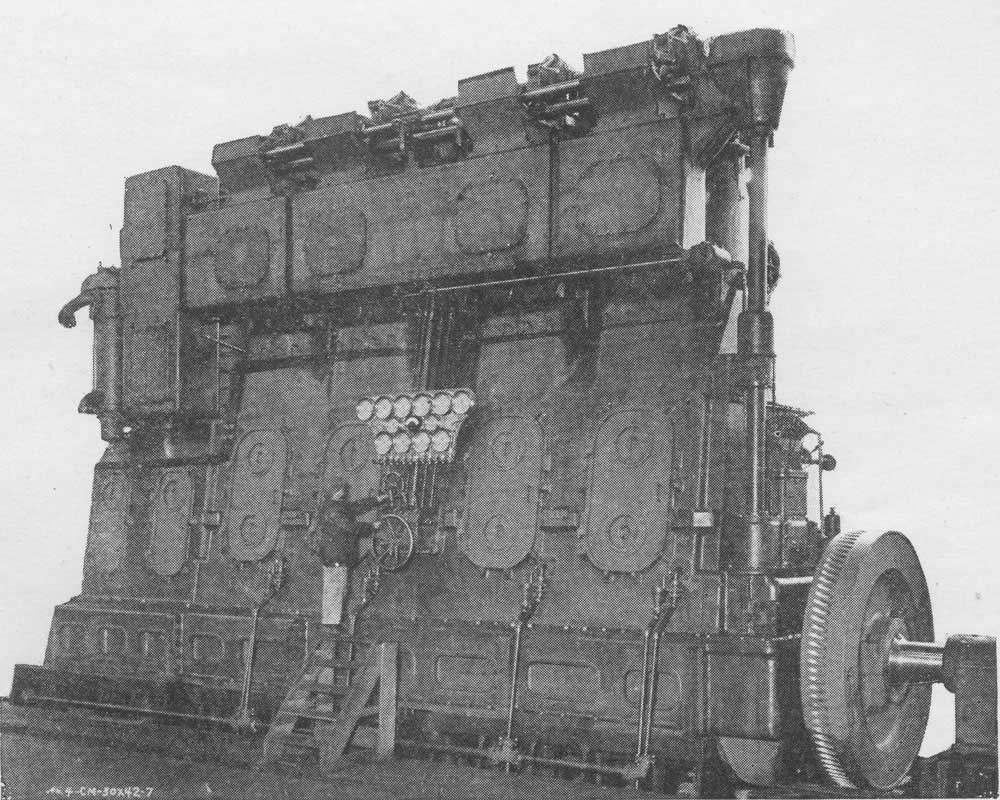
The tanker E.T.Bedford was built in 1921 by the Federal Shipbuilding yard at Kearny NJ on the Hackensack River. This yard was a subsidiary of U.S. Steel and built ships from the World War One period until the end of World War Two when the yard closed permanently.
It was allocated hull #49 from the Federal Shipbuilding yard and was originally built as a steamship. It was part of a construction order for nine tankers, others in this batch were originally named 'Vancolite', 'Walter Jennings', 'Victolite' and 'Vancolite' again.
The tanker was named after E T Bedford (1849 - 1931), a director of the Standard Oil Company of New Jersey.
By December 1926 the ship's reciprocating steam engines had been replaced by two Busch-Sulzer 4S76 engines each developing 1,800hp at 90rpm.
On June 29th/30th 1933 the E T Bedford passed through the Panama Canal from Talara, Peru to Halifax, NS with 15,000 tons of crude oil.
On May 29th/30th 1936 the E T Bedford passed through the Panama Canal en-route from New York NY to Talara, Peru in ballast.
At the outbreak of World War Two the E.T. Bedford was engaged in the movement of crude oil between ports along the eastern seaboard of the USA, completing eight voyages during the last six months of the year. 1940 saw similar movements, completing a total of seventeen voyages, transporting over 73 million gallons of crude.
The routine continued during 1941, including many visits to Carribean ports, cargo carried was slightly more than that of 1940. In April 1941 the E.T.Bedford was ordered into the Pacific area, transitioning via the Panama Canal.
During the middle of May 1942 the E.T. Bedford was delivering a shipment of petroleum products to five terminals in the Sydney, Australia area. Her cargo consisted of just over 115,000 barrels, the greater majority was 100 octane aviation gasoline, the remainder being Pool vapourising oil. Arrival was about midday on May 28th, by June 2nd the last terminal had been reached and the last of the cargo unloaded. Whilst in the process of discharging cargo on June 1st the harbour was raided by Japanese midget submarines, the USS Chicago was moored nearby and was able to detect the midget submarines and coordinate countermeasures. Depth charges dropped near the E.T Bedford caused leaks in the hull plates, investigation showed the damage to be serious. Leaving Sydney a small shipment of 73 octane gasoline was delivered to Townsville. After discharging the cargo the E.T.Bedford sailed for San Francisco, arriving here on June 27. The next six months were spent repairing the hull and engines.
1943 saw the vessel crossing the Pacific with deliveries to Australia, in particular Sydney & Brisbane, with various cargoes including 80 octance gasoline and diesel fuel. Later in the year runs were made from the west coast of the USA to Pearl Harbour.
In March 1944 whilst travelling from San Pedro, California to Espiritu Santo the ship was turned over by the War Shipping Administration to the Standard Oil Company of New Jersey. After arriving at Espiritu Santo in the middle of March, it was then off to Noumea (March 30th), Balboa, (May 1st), Covenas (May 9th) and Aruba (May 14th). From here it was off to Paulsboro for delivery to the War Emergency Tankers Inc late in May 1944. To this point, from 1939 the ship had made fifty six sailings transporting almost six million barrels of petroleum related products.
During July 1944 Standard Oil Company of New Jersey purchased eight new 14.5 knot tankers which were built by the Sun Shipbuilding and Dry Dock Company, with fifteen old tankers traded as an allowance of $10,778,640 on the purchase price of $24,000,000 for the new tankers. The new tankers would be named in the 'Esso' series. The fifteen tankers traded in were the C A Canfield, Edward L Doheny, Glenpool, F Q Barstow, Frederic R Kellogg, R G Stewart, George W Barnes, E G Seubert, S B Hunt, Vistula, E T Bedford, Walter Jennings, Christy Payne, Chester O Swain and Thomas H Wheeler.
Towards the end of World War Two the vessel was acquired from the WSA and commissioned at Pearl Harbor June 23rd 1945 and was renamed Guardoqui (IX-218). The tanker was originally intended for use as Mobile Floating Storage and departed Pearl Harbor for Eniwetok on July 27th 1945. By August 12th the Guardoqui had reached Eniwetok, spending the next month discharging the cargo of fuel and lube oil to navy and merchant ships. Guardoqui left here on September 7th reaching Tokyo by September 21st to discharge more lube and fuel oil.
Six weeks were spent here before departing Tokyo on November 7th, travelling via Pearl Harbor and the Panama Canal, reaching Mobile, Alabama on January 6th 1946. Here the Guardoqui was decommissioned on February 13th 1946, returned to the WSA and finally struck off the Navy List on April 12th 1946. The vessel was sold by the Maritime Commission during January 1947 to H H Buncher Company, agent for Liberty Industrial Salvage Company.

Built: Federal Shipbuilding Yard, Kearny, New Jersey
Launched: 1921
Tonnage: 15,665 dwt
Length: 510 feet
Breadth: 68 feet
Draught: 38 ft
Propulsion: Two Busch-Sulzer 4-CM- 30x42 1,800 bhp (at 90 rpm) 4 cylinder diesel engines (4S76 model)
Screws: Two
Speed: 9.9 knots
Cargo: 119,414 barrels, pumping rate 4,500 barrels per hour
Resources:
National Library of Australia : Trove website of archived Australian Newspapers (trove.nla.gov.au)
Busch-Sulzer Marine Diesel Engines brochure c1928 16 pages
Busch-Sulzer motorship publication c1931 48 pages
Esso Fleet Tankers of World War II 1946
Miscellaneous sources from a variety of websites - all of which featured parts of the service lives of these vessels.
Page added April 23rd 2007
Last updated November 6th 2022
Return to Ship descripton menu
Return to Ship list menu
Return to site menu